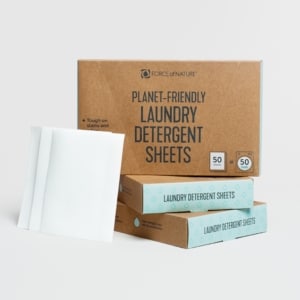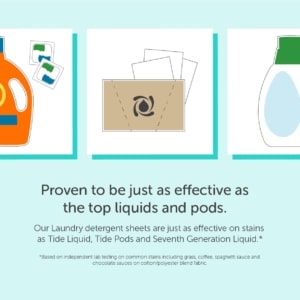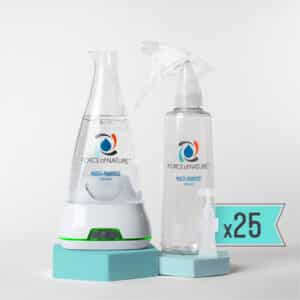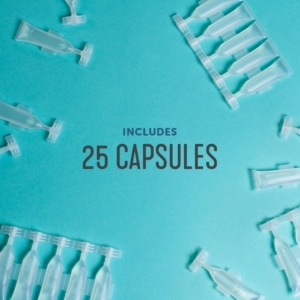
You can picture the television commercial in your head: a woman is enjoying a peaceful shower, no children are hassling her, sunlight streams in the windows as she lathers up a loofah with that rich, decadent foam and breaths in some refreshing, rejuvenating scent like eucalyptus or mint. We’ve been conditioned over decades to expect our personal care products to be rich, foamy and heavily scented. Sadly, the chemicals that go into making that happen bring a downside that far outweighs that moment of spa-like zen. We’re here to help you identify the worst of the worst and avoid them, so you can enjoy your next shower with a toxic chemical free body wash and the peace of mind that comes with it. Whether your shower will be hot, or that you’ll get to enjoy it in peace with no toddler witnesses – that we can’t guarantee.
Choosing a Toxic Chemical Free Body Wash: The Top 5 Ingredients to Avoid
1. Fragrances
Scent is one of the features that we select our body washes for, but fragrance is one of the top things you will want to avoid in your search for a chemical free body wash. One “fragrance” ingredient listed on a product label actually designates the presence of perhaps hundreds of potentially toxic substances. Many of these ingredients have been associated with endocrine disruption, organ toxicity, neurotoxicity, allergies, asthma, and even cancer. The Environmental Working Group warns consumers to read the word “fragrance” or “parfum” and translate it to mean “hidden chemicals”. To avoid fragrances, choose only fragrance free body washes and use high-quality, uncontaminated essential oils to fragrance them yourself. Always choose fragrance-free products over “naturally” scented products, as even so-called “natural” fragrances can be as unsafe as synthetic ones. In fact, even “unscented” products may contain fragrance ingredients that are masking scents, so make sure to read the label.
If that doesn’t compel you to put down that sweet-smelling body wash, here is a word that should: PHTHALATES. Phthalates are almost unavoidable in fragrances because they make scents last longer, though you won’t see this toxic ingredient listed on labels. They have been banned for cosmetic use in the European Union and the National Toxicology Program has designated them “reasonably anticipated to be a human carcinogen”. Add to that reproductive & developmental toxicity and endocrine disruption, decreased sperm counts and damaged sperm, and you have yet another very compelling reason to avoid all fragranced products. You might wonder how can fragrances be so dodgy. The reason is that the fragrance industry is self-regulated. That means that there’s no agency overseeing fragrance ingredient safety & chemical disclosure to consumers.
2. Cocamidopropyl Betaine
This is where the lather happens. Cocamidopropyl betaine is a common ingredient in many personal care products, like body wash, because it’s a surfactant that helps increase suds. Unfortunately, it can cause allergic dermatitis and skin irritation. In fact increasing rates of sensitization led to cocamidopropyl betaine being named Allergen of the Year by the American Contact Dermatitis Society. To avoid this ingredient, read product labels and only choose products that are free of the following ingredients: cocoyl amid propyldimethyl glycine; 1-propanaminium, 3-amino-n-(carboxymethyl)-n,n-dimethyl-,n-coco acyl derivs., inner salts; cocamidopropyl dimethyl glycine; 1-propanaminium, n-(carboxymethyl) –n, n-dimethyl-3-[(1-oxococonut) amino]-, hydroxide, inner salt; 1propanaminium, 3 aminon (carboxymethyl) n,ndimethyl, ncocoacyl derivs., hydroxides, inner salts; hydroxide inner salt 1-propanaminium, n-(carboxymethyl) –n, n-dimyethl-3-[(1-oxococonut) amino]-; CADG; cocamido betaine; cocaminopropyl betain; cocoyl amid propylbetaine; cocoyl amid propyldl methyl glycine solution; cocoyl amide propyldimethyl glycine; hydroxide inner salt 1-solution.
3. Methylisothiazolinone (MIT)
Methylisothiazolinone is a preservative that’s often used in place of parabens (these are associated with endocrine-disruption so look out for these too) in personal care products. Unfortunately, this ingredient can cause allergic reactions, irritation to the skin, eyes, and lungs and is also linked to neurotoxicity. To avoid methylisothiazolinone, be sure to read ingredient labels and avoid products that contain MIT and any of the other synonyms like MICROCARE MT or NEOLONE 950 PRESERVATIVE used to designate the presence of this chemical. If you have sensitive skin, you should take special care to avoid products that contain MIT. Finding a toxic chemical free body wash would definitely be your best bet if you have sensitive skin.
4. Retinyl Acetate
Retinyl acetate is a synthetically produced vitamin A ingredient that’s used as a skin conditioning agent in products like body washes. It can be toxic in high doses for pregnant and lactating women. This ingredient can cause biochemical and cellular changes in the body as well as organ system toxicity. To avoid retinyl acetate, read the ingredient label on body wash products before you buy them and avoid any that list the following ingredients on the label: vitamin A acetate; retinyl acetate; acetic acid, retinyl ester; retinol acetate; retinyl acetate (vitamin A acetate); myvax; retinyl ester acetic acid; all-trans-retinyl acetate; crystalets; myvak; trans-vitamin A acetate.
5. Retinyl Palmitate
Retinyl palmitate is an ingredient that’s manufactured partially from palmitic acid and partially from retinol or vitamin A. It’s a skin-conditioning agent in products like body wash. Retinyl palmitate is found in many personal care products even though an FDA study showed that this ingredient, when applied to the skin, can cause an increased risk of skin cancer. Another concern is that retinyl palmitate, as a vitamin A based ingredient, can cause an overdose of vitamin A which is particularly significant for pregnant and lactating women. To avoid this ingredient, avoid products that contain retinyl palmitate, vitamin A palmitate, or any synonyms of this ingredient. Instead, choose a toxic chemical free body wash.
Learn More
So, now that we’ve told you everything to avoid, how do you go about finding a toxic chemical free body wash that you can feel good about? You can find safe alternatives by going to the EWG Skin Deep Database. This resource makes it possible for you to search for both ingredients to learn more about them or search for products that are free of toxic substances. We know it can be overwhelming learning about these products, so one great way to find out about new products is to follow brands (like us!) who are committed to supporting others in the non-toxic space. Take it one step at a time and know that any shift towards safer products is a good thing! And you can probably guess we’d say this, but if you can avoid only one ingredients on this list, make it FRAGRANCES!
For lots more information, resources and our Chemical Free Product Guides, swing by our blog.



